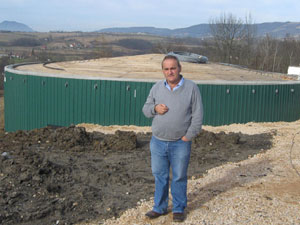Annual earnings of approximately €100,000 - First biomass power plant in Serbia put in operation in village of Dragacica near Guca
 Tuesday, 16.11.2010.
Tuesday, 16.11.2010.
 15:50
15:50

The first mini biomass power plant has been opened in the village of Dragacica near Cacak. A digester, with the capacity of 6,000 kWh per year and the nominal power of 75 kW per hour, will be using corn silage as a fuel.
This power plant will be consuming about 1.5 tons of corn silage a year. What is especially important is that, in addition to the primary output of the system, the power plant also produces 400,000 liters of soil for flowers and about 1,000,000 liters of liquid for fertilizing cultivated fields as by-products.- The power plant is a technologically very simple solution: the complex comprises a storage unit, a biogas production unit and an electric power production unit - says Milan Filipovic, the owner of the plant.
Filipovic, who is a mechanical engineer by profession, has designed this system by himself.
The temperature of exhaust gases is about 500 degrees, which can be used, by means of a simple hot water pipeline system, for heating the ethno-village that Filipovic builds about hundred meters away from the power plant. A period of 120 days needs to pass between the first charging and the production of the first electric power. The entire gas produced here is intended for consumption, while the gas engine is made by Scania.
I am not reinventing the wheel
Concerning the fact that the power plant is built in a hilly landscape where the lots planted with corn occupy small surfaces, the question arises: if Filipovic has made a good calculation:
- I did not have to calculate much. All I needed to do is to see what the rest of the world has already done. Germany has about 6,000 such power plants, Austria has about 1,200, while about 200 such plants are situated in Hungary. Why shouldn't we have them too. We should not reinvent the wheel but only take the one already made.
As Milan Filipovic explains for eKapija, about 200,000 euros have been
invested in construction of the power plant, 25,000 euros of which have been provided
from the loan granted by the Development Fund, while the rest of the costs have been covered by themselves.
According to the information available to Filipovic, the price of such facility in the global market ranges between 660,000 and 1 million euros.
If somebody told him ten years ago that electric energy would be produced in his home village in the vicinity of Lucani, Filipovic would call that person crazy.
- It seemed impossible. But when the Feed-in Law was adopted, that became possible and profitable.
Namely, by adopting the Feed-in Law, the state promised to purchase alternative energy prior to 2012. The state pays 1 kWh 0.16 euros. Filipovic's power plant can produce 6,000 kWh in one year so that his annual income from electricity amounts to 96,000 euros.
And what does the state say?
(Milan Filipovic and Zeljko Radosevic)
The power plant has been opened by
Zeljko Radosevic, the State Secretary in the Ministry of Agriculture,
Forestry and Water Power Engineering of Serbia, who underlined the significance of production of electric and heating energy with the use
of biomass.
Radosevic says that the Ministry of Agriculture has recognized the importance of promotion of renewable sources of energy so that appropriate bylaws are planned to be prepared with the aim of more efficient using of biomass.
- Serbia has the potential of about 12.5m tons of biomass, mainly in agriculture. By the end of 2012, 7.7% more electric energy is planned to be produced in this way, which would be enough for about 175,000 households - says Radosevic.In that way, agricultural manufacturers will have more opportunities to make additional incomes and exploit less valuable land to produce biomass.
Collaborators
Biomass, which we have had a chance to see in Dragacica, is collected from 17 ha of land, which is enough for the power plant to stay in operation until spring.
The price of biomass is 252 euros per
ton of silage on the scale. Agricultural manufacturers would earn 1,200
euros per hectare of corn silage in that way. Since the vegetation
period is short, it is possible to sow twice a year, first corn and then
field pea or barley. Both cultures can be used for biomass.
Plans
Convinced in the profitability of his project, Filipovic says for our portal that, if he gets a favorable loan, construction of another power plant will start as soon as tomorrow.
When asked when he expected the invested money to return, he jokingly replied:
- It does not have to return at all. I did not sell the land I inherited from my father to built the plant so I have nothing to regret.
Suites in ethno-village
Milan Filipovic has also built an ethno-village on his property, the construction of which started five years ago. The village currently comprises seven suites.
- The whole family, my wife and three kids, participate in the business. We spend all our leisure time in Dragacica and our idea of rural tourism have already been adopted by some other inhabitants of the village - says Filipovic.
J.Đ.


 Izdanje Srbija
Izdanje Srbija Serbische Ausgabe
Serbische Ausgabe Izdanje BiH
Izdanje BiH Izdanje Crna Gora
Izdanje Crna Gora


 News
News







